|
NO
matter how small or how large a town, its
citizens and visitors must eat and sleep, and
boarding houses and hotels become necessary
establishments.
From the days of "Uncle Jimmy" Renshaw's
log cabin tavern to the modern hotels of Decatur
today, the city has been provided with a good
class of hostelries. In the beginning they
were crude, just as the town was crude, but they
kept pace with the city, and today are on a par
with the hotels of the largest cities.
Renshaw's tavern, as stated elsewehre,
was Decatur's first place of business, started
in 1829. The tavern was a log cabin,
standing on the present site of the Lincoln
theater entrance. In connection with the
tavern was conducted a store. Mr.
Renshaw was in business there a number of
years and was quite successful.
THE HARRELLS
For many years during the early history of
Decatur the name of Harrell was associated with
the boarding house and hotel business.
"Landlady" Harrell had a wide
reputation and was popular with the traveling
public. She had come to Decatur in 1829.
For a long time she had a tavern on the north
side of the old square. Later she and her
sons ran what is known as Social hall south of
the square. Her sons, John and Land
Harrell
purchased that hall in 1853 and refurnished it.
In 1854 they built the hotel which later was
replaced by the St. Nicholas. Mrs.
Harrell remained there in charge for some
time, and later conducted a boarding house on
Wood street, which she continued up until the
time of her death in September 1868.
The hotel built by the Harrells was a
three story building. That hotel had many
different names and different proprietors before
it finally came into possession of the Laux
Brothers and was named the
St. Nicholas, the name it had since kept.
It was known as the Harrell House, the
Cassell
House, the Shoaff house, the Tremont
house, the Oglesby house.
Varney's hotel and the
Cloudas House.
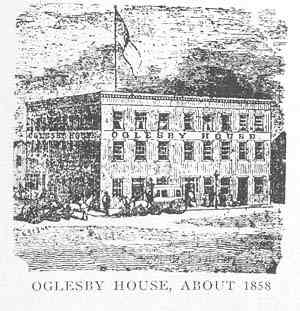
When it was the Oglesby house it was
run by Willis Oglesby, son of the Willis
Oglesby who brought the orphan lad, Richard
J. Oglesby, to Decatur. This Willis
Oglesby came here in 1855. His little
daughter was killed by falling through the
banisters in the hotel, and the father then gave
up the business. Mr. Oglesby was
killed later in the battle of Shiloh during the
Civil war.
The Laux brothers, Nicholas, Peter and
Charles, in 1861 bought the hotel from L. B.
Wing of Urbana, who had come into possession
of it through having loaned money on it.
It had been known then as the Cloudas.
The Laux brothers changed the name to the St.
Nicholas. The original building was torn
down in 1865, and replaced by a three story
brick structure. In 1892 that building was
demolished to make room for a new five story
building, which is a part of the building in use
today. The ten story addition to the hotel
was erected in 1914.
The Laux brothers introduced some
innovations. Three kerosene lamps were
bought, the first of the kind in Decatur.
One was placed at the head of each stairway.
What a wonderful effect! Patrons were
delighted. The landlords arranged also for
the porter to fill pitchers with hot water, in
the mornings, if the guests would leave the
pitchers outside their room doors. How up
to date this hotel was.
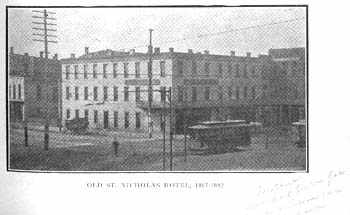
Old St. Nicholas Hotel,
(SHARON WICK'S NOTE:
My grandmother, Madge
Love Montgomery, wrote a notation in
pencil below this picture. It read "Mother
worked here for a while when she was a girl."
My grandmother was referring to her mother Sarah
Elizabeth Grindle
whose mother was Milly Ann Earp and her
father was Charles Grinnel/Grindle.)
To serve as a guide for the bus drivers a
lantern was hung in the window of the hotel at
night. It could be seen almost all the way
to the railroad station. The candles which
were used in the rooms were made at the hotel.
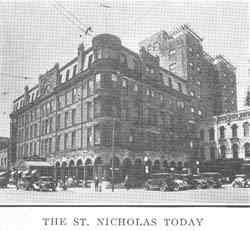
The St. Nicholas Today
Judging from the number of landlords at the
hotel before the Laux brothers took
charge, one would be likely to think that it was
hard sledding for the hotel. This was
probably true. After the railroads came, a
depot was built which included the a hotel,
known as Central house.
Practically all the transient business went
to the Central hotel because of its convenience
to the station. It was some years before
hotel business in the downtown district became
profitable. A hotel on East Eldorado
street, known as the Thorpe hotel, was
practically put out of business by the opening
of the Central hotel. This building was
sold, and later became St. Teresa's academy.
It had been built by John Humphrey
at the time the Great Western railroad had its
first station at Broadway street.
THE REVERE
Decatur's first real hotel, and the leading
establishment of the sort for many years, was
the Macon house, later known as The Revere.
From the time of its erection in 1839 until the
day it was destroyed by fire in 1871, it was the
best known and most important realized until
after the hotel was burned.
The original building of the Macon house
consisted of two stories and basement,
containing twelve bedrooms and a large attic.
The building had 50 foot frontage on Franklin
street and 30 fee on Prairie.
The hotel was erected for Captain David L.
Allen and Dr. Thomas H. Read by
Edward O. Smith. It was run first
by Mrs. Elizabeth Nesbitt and two sons,
James and Washington. They had charge of
the place until 1841, when it was taken over by
John Eckel. He continued it for
about a year. In 1842 David Krone
became she proprietor and he conducted the hotel
until 1850.1
Many stories have been told of the regime of
the hotel under the Krone management.
Those were the days when it was visited by
Abraham Lincoln, Judge David Davis,
Leonard Swett and other notable members
of the bar. It was said that often the
lawyers, who was riding the circuit in those
days, prolonged court sessions in Decatur
because of the splendid hotel service. It
was something they didn't get in many of the
cities of that time. Mother Krone's
cooking became famous.
"Have rented the tavern stand together with
the stable and appurtenances thereunto
belonging, commonly known as the Macon house in
Decatur.
The lessors agreed to furnish the necessary
bedding, beds and furniture, also all necessary
feed for stable, and the said Krone "has
the privilege of feeding two cows from the same
without charge" They agreed also to
furnish Krone with firewood he might need
in the tavern. The wood was to come from
any timber belonging to Allen and Read, but
Krone was to cut and haul the wood at his
own expense.
The rent for the hotel was to be half the
total receipts. It did not matter whether
it was paid in produce, money or trade.
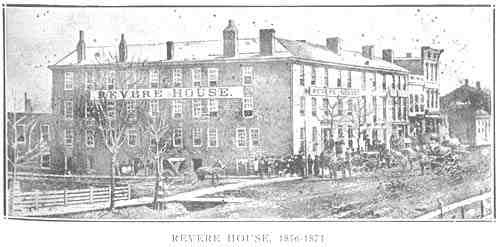
Revere House
The hotel was prosperous during the Krone
regime. The next proprietor was Jesse H.
Elliott, and he stayed only about a
year. George W. Baker was another
of the proprietors in the interval of time from
the Krones to Hugh Taylor, who
bought the hotel in 1856. Mr. Taylor
made extensive additions to the hotel. He
built both on the east and on the south, and
also added another story. These
improvements made it a sixty room hotel.
It was then called the Taylor house.
Taylor
sold out in two years to Colonel Samuel Clark
of Springfield. Clark's son-in-law W. L.
Barnum, because the proprietor and the hotel
then has known as the Barnum house.
Darlington Turnbolt took charge of the
place about 1859 and remained until 1865.
From 1861 to 1865 L. R. Cain was
associated with him, and part of the time they
ran to St. Nicholas hotel also.
Turnbolt
sold out to E. G. Egbert who came from
Keokuk in 1865. Egbert died in
about a year, but his family continued the hotel
for a time.
The next landlord, Dr. Ross, didn't
last very long, but while he was at the hotel,
it is said, he taught people what real food was.
He engaged in chef at a handsome salary, and his
meals became famous over the state. A
banquet menu in those days puts a modern day one
to shame. At one such event for newspaper
editors in 1866 more than ninety varieties of
food were served. Newspaper editors can
eat when they have the chance!
DESTROYED BY FIRE
Other landlords that followed were A. F.
Cochran, Willis Brothers and M. C.
Hicks. Mr. Hicks bought the
property from Colonel Clark in 1871.
He had been conducting the hotel only about two
months, when fire broke out and laid it in
ruins. That fire occurred April 7, 1871.
It was thought that a guest left a gas jet
burning, and that curtains or wallpaper caught
fire from the flame.
Some of the traveling public in those days
were not accustomed to gas lights.2
If Decatur had had a fire department of the
kind it has today, the Revere house would never
had burned, but all it had was a volunteer
bucket brigade. The fire burned slowly for
hours.
The blaze had started early in the morning,
and as fast and as long as possible guests and
hotel employes cast out or carried out household
effects, personal belongings and anything they
could get their hands on. Some of the
guests, it was told, had to pick their clothes
out from a heap thrown into Central park before
they could dress.
B. O. McReynolds nearly lost his life
in that fire. He was on the second floor
helping to get things out when the floor gave
way. He fell in such a way that portions
of the fallen floor nearly covered him. and it
was with great difficulty that he finally was
extricated by George W. Kraft and Mr.
Archer. He was in agony before
released, being crushed and burned. He
carried marks of the injuries until his death.
Mr. McReynolds at that time was in the
dry goods business with J. F. Roach,
their store being on South Park and State
streets. He was one of the first at the
Revere house after the fire was discovered.
Up to that time, The Revere house had been
the hub of the city. All travel from the
railroad stations up to the center of the town
passed that way. Buses made their stops
there, before going farther. The hotel had
an excellent reputation and was known all over
the state.
CHANGES SITUATION
When the Revere house burned and was not
rebuilt, it meant that the section of the
business part of the city bordering on the New
Square, now Central park, had lost its main
attraction. No longer was the new square
in the lead in the business rivalry between the
old and the new squares. Gradually
business fell off in the neighborhood of
Franklin and North and South Park streets.
Water street became heir to a number of
enterprises. Only the most undesirable,
mostly saloons and gambling dens, remained on
Franklin, and soon that street gained a rather
notorious reputation. The old square came
into its own and Water and Main streets
flourished as the businesses section.
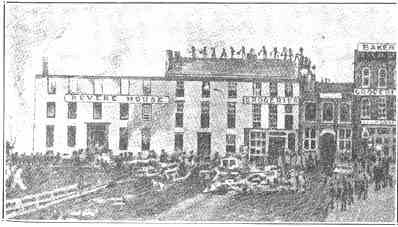
THE REVERE HOUSE FIRE, 1871
It has been only in comparatively recent
years that the streets to the north, south and
east of Central Park have regained their
business standing, due to the necessary
expansion of the business district. The
automobile trade largely ahs brought it about.
Yet it never has returned and probably never
will return to the place it once occupied as
Decatur's business center. The burning of
the Revere house was the event that brought on
the loss of its prestige.
PRIEST HOTEL
Hotels grew in number and in size with the
passing of the years. For a long time the
Priest hotel on the northwest corner of the Old
Square was one of the leading establishments.
That building was started by W. S. Crissey
about 1860. When the north and south walls
were up, work stopped for lack of funds.
The property later was bought and the building
finished by Franklin Priest, who ran a hotel
there for many years.
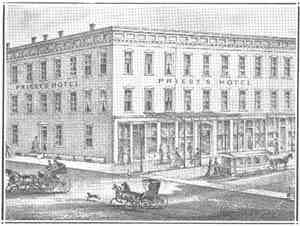
PRIEST HOTEL 1969
In 1880 Riley Deming became proprietor
and the name was changed to the New Deming.
Oscar Spalding
followed him as manager.
In 1892 the property came into the hands of
A. Wait and it was opened as the Arcade
hotel. In 1900, after being rebuilt and
enlarged by Mr. Wait, it became the
Decatur hotel, with F. B. Stearns as
manager. In 1904 the hotel burned, but it
was rebuilt. It passed through various
changes in management until 1915 when the hotel
again was destroyed by fire. This time it
was not rebuilt as a hotel, though the structure
which now stands on the site still houses an
eating place, the Lincoln cafe.
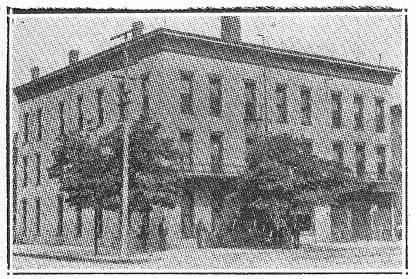
BRUNSWICK HOTEL
The Brunswick hotel building is probably the
oldest hotel now standing in the city. It
was erected about 1860. Its first - or one
of the first - proprietor was Thomas B.
Albert. Until sometime in the 70's the
place was known as the Pennsylvania house, and
later it was called the American for a time.
Since about 1885 it has been known as the
Brunswick. Another old hotel in the
downtown district is the St. James, which was
built about 1875.
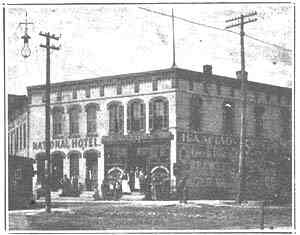
NATIONAL HOTEL, 1894
Hotels became rather numerous in the vicinity
of the railroad stations. One that stood
for many years was the National at Front and
Cerro Gordo streets, where the Kraft hotel now
stands. It was run by John McEvoy.
A picture shows the hotel and the saloon in
connection with it, a sight familiar to the old
time residents but not to the present day
generation. It was replaced by the Kraft
hotel in 1907.
--------------------
1
The proprietor of the Macon house before
Landlord
Krone
had a bar in the basement.
Krone did not have one. When people
asked him if he had anything to drink he would
reply "Nothing stronger than coffee."
The Daily Republican of Decatur had the
following item in its issue Sept. 9, 1869:
"A couple of Springfield youths came to the
Revere house Tuesday evening and when they
retired for the night, not being accustomed to
the luxury of gas in the quiet village where
they were born and reared, they treated the jet
as they were accustomed to serve the tallow dip,
and went to sleep. Their mistake was
fortunately discovered by the clerk before any
serious effects had resulted and the chaps
escaped with nothing more than headache and sick
stomachs."
2 (Sharon
Wick's Note: There was no
Number 2 footnote in the book)
<PREVIOUS> <NEXT>
<CLICK HERE TO RETURN TO TABLE OF CONTENTS>
|